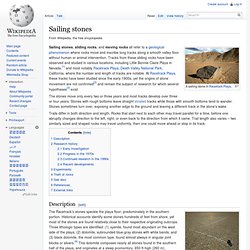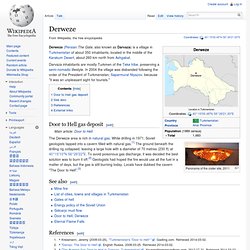

40 Of The Most Powerful Photographs Ever Taken. Sailing stones. Sailing stones, sliding rocks, and moving rocks all refer to a geological phenomenon where rocks move and inscribe long tracks along a smooth valley floor without human or animal intervention.

Tracks from these sliding rocks have been observed and studied in various locations, including Little Bonnie Claire Playa in Nevada,[1] and most notably Racetrack Playa, Death Valley National Park, California, where the number and length of tracks are notable. At Racetrack Playa, these tracks have been studied since the early 1900s, yet the origins of stone movement are not confirmed[2] and remain the subject of research for which several hypotheses[3] exist. The stones move only every two or three years and most tracks develop over three or four years. Stones with rough bottoms leave straight striated tracks while those with smooth bottoms tend to wander.
Stones sometimes turn over, exposing another edge to the ground and leaving a different track in the stone's wake. Description[edit] ice floes. Racetrack Playa. The Racetrack Playa, or The Racetrack, is a scenic dry lake feature with "sailing stones" that inscribe linear "racetrack" imprints.

It is located above the northwestern side of Death Valley, in Death Valley National Park, Inyo County, California, U.S.. Geography[edit] The Racetrack Playa is 3608 feet (1130 m) above sea level, and 2.8 mi (4.5 km) long (north-south) by 1.3 mi (2.1 km) wide (east-west). The playa is exceptionally flat and level with the northern end being only 1.5 inches (4 cm) higher than the southern. This occurrence is due to major influx of fine-grained sediment that accumulates at the north end. 360° night-time panorama of the Racetrack Playa. Features[edit] The Racetrack[edit] Racetrack is dry for almost the entire year and has no vegetation.
During the bimodal rainy season (summer and especially winter) a shallow cover of water deposits a thin layer of fine mud on and between the polygons of Racetrack. Sailing stones[edit] Sailing stone in Racetrack Playa Islands[edit] Mount Sanqing. Mount Sanqing (Chinese: 三清山; pinyin: Sānqīng Shān) is a renowned Taoist sacred mountain located 25 miles (40 km) north of Yushan County in Jiangxi Province, China with outstanding scenery. Sanqing means the "Three Pure Ones" in Chinese as Mount Sanqing is made up of three main summits: Yujing, Yushui, and Yuhua, representing the Taoist trinity. A Chinese phrase “三峰峻拔、如三清列坐其巅” (“Three steep peaks, like the Three Pure Ones sit the summits”) explains why it was named San Qing. Amongst the three hills, the Yujing hill (1817 meters above sea level) is the highest. Gallery[edit] Derweze. Derweze (Persian:The Gate, also known as Darvaza) is a village in Turkmenistan of about 350 inhabitants, located in the middle of the Karakum Desert, about 260 km north from Ashgabat.

Darvaza inhabitants are mostly Turkmen of the Teke tribe, preserving a semi-nomadic lifestyle. In 2004 the village was disbanded following the order of the President of Turkmenistan, Saparmurat Niyazov, because "it was an unpleasant sight for tourists. " Door to Hell gas deposit[edit] Panorama of the crater site, 2011. The Derweze area is rich in natural gas. WikiMiniAtlas 40°15′10″N 58°26′22″E / 40.25264°N 58.43941°E / 40.25264; 58.43941 (The Gates of Hell). See also[edit] References[edit] External links[edit] Fengdu County. Fengdu[edit] The Fengdu Ghost City is a tourist attraction modelled after Diyu, the concept of hell in Chinese mythology and Buddhism.
It was built over 1,800 years ago. The ghost city will become an island once the Three Gorges Dam project is completed. Specifically, part of the Fengdu Ghost City will be submerged, but scenery above the "Door of Hell" will remain. Image gallery[edit]